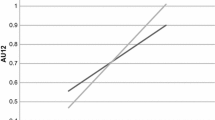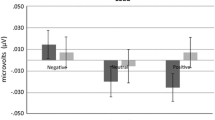Abstract
The aim of the present study was to test the classic but under-researched hypothesis that individual differences in automatic emotional mimicry are positively related to individual differences in emotional contagion. To tap automatic mimicry and automatic emotional contagion, participants were exposed to affective stimuli with either a positive or negative valence (faces with a happy expression, n = 73; faces with a sad expression, n = 73) while their attention was directed toward nonaffective features of the stimuli. Emotional mimicry was measured with EMG (Corrugator, Zygomaticus). On average, in the sad emotional expression condition, participants’ mood worsened, but the happy emotional expression condition did not evoke a general positive emotional contagion effect (across participants). Multigroup multilevel latent difference models revealed that in the sad emotional expression condition, individual differences in Corrugator activity were related to a larger increase in unpleasant mood, and in the happy emotional expression condition, individual differences in Zygomaticus activity were related to a larger decrease in unpleasant mood. That is, results of this study provided support for the mimicry-contagion link.





Similar content being viewed by others

Notes
It is interesting to note that for the concept of emotional contagion, a parallel differentiation was suggested: Neumann and Strack (2000) argued that a largely unconscious, automatic form of catching another person’s feelings should not result in a discrete emotion (i.e., an objected-directed state such as pride or anger) but in a congruent mood state (i.e., a diffuse state that is not directed toward a specific object; e.g., pleasant versus unpleasant mood). Neumann and Strack’s (2000) empirical findings largely confirmed this idea, and this is also why the authors preferred the term mood contagion over emotional contagion.
We checked whether a log-transformation of the EMG data would change the results. Results on mean differences within and across experimental conditions and on individual differences in Corrugator and Zygomaticus activity predicting mood change remained the same. Hence, we report the results for the non-transformed EMG scores.
References
Baumeister, R. F., Bratslavsky, E., Finkenauer, C., & Vohs, K. D. (2001). Bad is stronger than good. Review of General Psychology,5, 323–370. https://doi.org/10.1037/1089-2680.5.4.323.
Blairy, S., Herrera, P., & Hess, U. (1999). Mimicry and the judgment of emotional facial expressions. Journal of Nonverbal Behavior,23, 5–41. https://doi.org/10.1023/A:1021370825283.
Cho, H.-C., & Abe, S. (2013). Is two-tailed testing for directional research hypotheses tests legitimate? Journal of Business Research,66, 1261–1266. https://doi.org/10.1016/j.jbusres.2012.02.023.
Czarna, A. Z., Wróbel, M., Dufner, M., & Zeigler-Hill, V. (2015). Narcissism and emotional contagion. Social Psychological and Personality Science,6, 318–324. https://doi.org/10.1177/1948550614559652.
Dimberg, U., Thunberg, M., & Grunedal, S. (2002). Facial reactions to emotional stimuli: Automatically controlled emotional responses. Cognition and Emotion,16, 449–471. https://doi.org/10.1080/02699930143000356.
Doherty, R. W. (1997). The Emotional Contagion Scale: A measure of individual differences. Journal of Nonverbal Behavior,21, 131–154. https://doi.org/10.1023/A:1024956003661.
Engelen, E.-M., & Röttger-Rössler, B. (2012). Current disciplinary and interdisciplinary debates on empathy. Emotion Review,4, 3–8. https://doi.org/10.1177/1754073911422287.
Estow, S., Jamieson, J. P., & Yates, J. R. (2007). Self-monitoring and mimicry of positive and negative social behaviors. Journal of Research in Personality,41, 425–433. https://doi.org/10.1016/j.jrp.2006.05.003.
Fridlund, A. J., & Cacioppo, J. T. (1986). Guidelines for human electromyographic research. Psychophysiology,23, 567–589. https://doi.org/10.1111/j.1469-8986.1986.tb00676.x.
Geiser, C., Eid, M., Nussbeck, F. W., Courvoisier, D. S., & Cole, D. A. (2010). Analyzing true change in longitudinal multitrait-multimethod studies: Application of a multimethod change model to depression and anxiety in children. Developmental Psychology,46, 29–45. https://doi.org/10.1037/a0017888.
Goeleven, E., De Raedt, R., Leyman, L., & Verschuere, B. (2008). The Karolinska Directed Emotional Faces: A validation study. Cognition and Emotion,22, 1094–1118. https://doi.org/10.1080/02699930701626582.
Gross, J. J. (2015). Emotion regulation: Current status and future prospects. Psychological Inquiry,26, 1–26. https://doi.org/10.1080/1047840X.2014.940781.
Gump, B. B., & Kulik, J. A. (1997). Stress, affiliation, and emotional contagion. Journal of Personality and Social Psychology,72, 305–319. https://doi.org/10.1037/0022-3514.72.2.305.
Hatfield, E., Cacioppo, J. T., & Rapson, R. L. (1992). Primitive emotional contagion. In M. S. Clark (Ed.), Review of personality and social psychology: Emotion and social behavior (Vol. 14, pp. 151–177). Newbury Park, CA: Sage.
Hess, U., & Blairy, S. (2001). Facial mimicry and emotional contagion to dynamic emotional facial expressions and their influence on decoding accuracy. International Journal of Psychophysiology,40, 129–141. https://doi.org/10.1016/s0167-8760(00)00161-6.
Hess, U., & Fischer, A. (2013). Emotional mimicry as social regulation. Personality and Social Psychology Review,17, 142–157. https://doi.org/10.1177/1088868312472607.
Hess, U., & Fischer, A. (2014). Emotional mimicry: Why and when we mimic emotions. Social and Personality Psychology Compass,8, 45–57. https://doi.org/10.1111/spc3.12083.
Hsee, C. K., Hatfield, E., Carlson, J. G., & Chemtob, C. (1990). The effect of power on susceptibility to emotional contagion. Cognition and Emotion,4, 327–340. https://doi.org/10.1080/02699939008408081.
Kelly, J. R., Iannone, N. E., & McCarty, M. K. (2016). Emotional contagion of anger is automatic: An evolutionary explanation. British Journal of Social Psychology,55, 182–191. https://doi.org/10.1111/bjso.12134.
Laird, J. D., Alibozak, T., Davainis, D., Deignan, K., Fontanella, K., Hong, J., et al. (1994). Individual differences in the effects of spontaneous mimicry on emotional contagion. Motivation and Emotion,18, 231–247. https://doi.org/10.1007/bf02254830.
Lakens, D. (2013). Calculating and reporting effect sizes to facilitate cumulative science: A practical primer for t-tests and ANOVAs. Frontiers in Psychology,4, 863. https://doi.org/10.3389/fpsyg.2013.00863.
Little, T. D., Cunningham, W. A., Shahar, G., & Widaman, K. F. (2002). To parcel or not to parcel: Exploring the question, weighing the merits. Structural Equation Modeling: A Multidisciplinary Journal,9, 151–173. https://doi.org/10.1207/S15328007SEM0902_1.
Lüdtke, O., Marsh, H. W., Robitzsch, A., Trautwein, U., Asparouhov, T., & Muthén, B. (2008). The multilevel latent covariate model: A new, more reliable approach to group-level effects in contextual studies. Psychological Methods,13, 203–229. https://doi.org/10.1037/a0012869.
Lundqvist, D., Flykt, A., & Öhman, A. (1998). The Karolinska Directed Emotional Faces (KDEF). Stockholm: Department of Neurosciences Karolinska Hospital.
Lundqvist, L.-O., & Dimberg, U. (1995). Facial expressions are contagious. Journal of Psychophysiology,9, 203–211.
Muthén, L. K., & Muthén, B. O. (1998–2017). Mplus user’s guide (8th ed.). Los Angeles, CA: Muthén & Muthén.
Neumann, R., & Strack, F. (2000). “Mood contagion”: The automatic transfer of mood between persons. Journal of Personality and Social Psychology,79, 211–223. https://doi.org/10.1037//0022-3514.79.2.211.
Nichols, A. L., & Maner, J. K. (2008). The good-subject effect: Investigating participant demand characteristics. The Journal of General Psychology,135, 151–165. https://doi.org/10.3200/GENP.135.2.151-166.
Papousek, I., Freudenthaler, H. H., & Schulter, G. (2008). The interplay of perceiving and regulating emotions in becoming infected with positive and negative moods. Personality and Individual Differences,45, 463–467. https://doi.org/10.1016/j.paid.2008.05.021.
Parkinson, B. (2011). Interpersonal emotion transfer: Contagion and social appraisal. Social and Personality Psychology Compass,5, 428–439. https://doi.org/10.1111/j.1751-9004.2011.00365.x.
R Core Team. (2018). A language and environment for statistical computing. Vienna, Austria: R Foundation for Statistical Computing. Retrieved August 1, 2018, from http://www.R-project.org/.
Raudenbush, S. W., & Bryk, A. S. (2002). Hierarchical linear models: Applications and data analysis methods. Thousand Oaks, CA: Sage.
Rozin, P., & Royzman, E. B. (2001). Negativity bias, negativity dominance, and contagion. Personality and Social Psychology Review,5, 296–320. https://doi.org/10.1207/S15327957PSPR0504_2.
Rusting, C. L., & Larsen, R. J. (1995). Moods as sources of stimulation: Relationships between personality and desired mood states. Personality and Individual Differences,18, 321–329. https://doi.org/10.1016/0191-8869(94)00157-N.
Sato, W., & Yoshikawa, S. (2007). Enhanced experience of emotional arousal in response to dynamic facial expressions. Journal of Nonverbal Behavior,31, 119–135. https://doi.org/10.1007/s10919-007-0025-7.
Sonnby-Borgström, M., Jönsson, P., & Svensson, O. (2008). Gender differences in facial imitation and verbally reported emotional contagion from spontaneous to emotionally regulated processing levels. Scandinavian Journal of Psychology,49, 111–122. https://doi.org/10.1111/j.1467-9450.2008.00626.x.
Sterba, S. K., & MacCallum, R. C. (2010). Variability in parameter estimates and model fit across repeated allocations of items to parcels. Multivariate Behavioral Research,45, 322–358. https://doi.org/10.1080/00273171003680302.
Widaman, K., & Reise, S. P. (1997). Exploring the measurement invariance of psychological instruments: Applications in the substance use domain. In K. J. Bryant & M. Windle (Eds.), The science of prevention: Methodological advances from alcohol and substance abuse research (pp. 281–324). Washington, DC: American Psychological Association.
Zinkernagel, A., Alexandrowicz, R. W., Lischetzke, T., & Schmitt, M. (2019). The blenderFace method: Video-based measurement of raw movement data during facial expressions of emotion using open-source software. Behavior Research Methods,51, 747–768. https://doi.org/10.3758/s13428-018-1085-9.
Acknowledgments
This work was supported by a grant to Tanja Lischetzke, Michael Niedeggen, and Michael Eid by the Cluster of Excellence “Languages of Emotion” at Freie Universität Berlin, funded by the German Research Foundation as part of the German Excellence Initiative. The authors would like to thank Stephan König for his help with Matlab.
Author information
Authors and Affiliations
Corresponding author
Ethics declarations
Ethical approval
All procedures performed in studies involving human participants were in accordance with the ethical standards of the institutional and/or national research committee and with the 1964 Helsinki declaration and its later amendments or comparable ethical standards.
Additional information
Publisher's Note
Springer Nature remains neutral with regard to jurisdictional claims in published maps and institutional affiliations.
Rights and permissions
About this article
Cite this article
Lischetzke, T., Cugialy, M., Apt, T. et al. Are Those Who Tend to Mimic Facial Expressions Especially Vulnerable to Emotional Contagion?. J Nonverbal Behav 44, 133–152 (2020). https://doi.org/10.1007/s10919-019-00316-z
Published:
Issue Date:
DOI: https://doi.org/10.1007/s10919-019-00316-z



